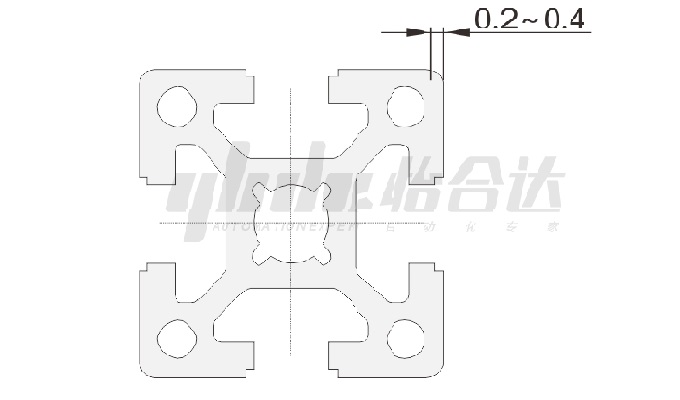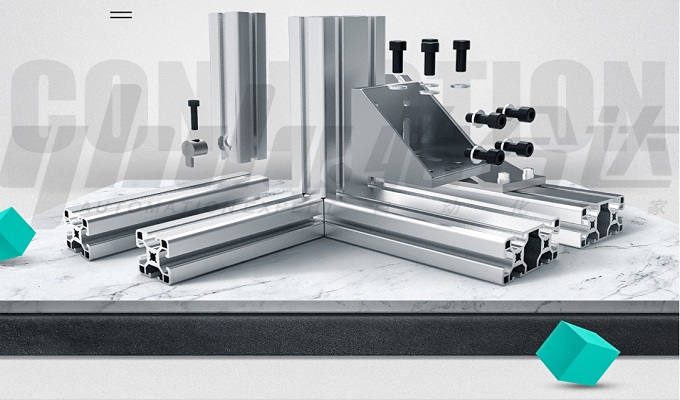Many people have difficulty distinguishing between the processes and applications of extruded aluminum profiles and die-cast aluminum. Let's explore the differences between these two processing methods. Extruded aluminum profiles are produced by extruding heated circular aluminum rods using an extrusion machine. Die-cast aluminum, on the other hand, is made from aluminum ingots and alloy materials melted in a furnace and formed in a die-casting machine. Die-cast aluminum products can be designed in various shapes, resembling toys, with diverse shapes that facilitate connections in different directions. Additionally, die-cast aluminum exhibits high hardness and strength and can be mixed with zinc to form zinc-aluminum alloys. Below, Yiheda will provide detailed explanations of the differences between these two aluminum processing methods.
Extruded Aluminum Profiles

The production process of extruded aluminum profiles involves the high-temperature extrusion of aluminum rods using an extrusion machine, followed by shaping. Various molds can be installed on the extrusion machine to produce aluminum profiles with different cross-sections.
Advantages of Extruded Aluminum Profiles
Less machining: Aluminum alloys can be extruded into complex shapes, reducing the need for mechanical processing when designed appropriately. Some shapes can only be obtained through extrusion, not achievable with other processes.
Low cost of aluminum extrusion molds: Compared to other competing materials like rolling, casting, forging, etc., the cost of aluminum extrusion molds is low.
High structural efficiency: Extruded aluminum profiles can achieve maximum structural efficiency. Named profiles can be used where strength is required, and aluminum can be removed where it is not needed.
Lightweight: Extruded aluminum alloy profiles are lightweight, sturdy, and durable. Due to performance differences between aluminum and other competing materials, the weight of aluminum structures achieving the same effect is approximately half that of other metal structures, which are less easily processed.
Various surface treatment options, strong corrosion resistance: Powder or electrophoretic coating can be applied to achieve any desired color. This includes natural silver or colored anodized coatings.
Low maintenance: Aluminum is a naturally durable metal, and the above surface treatments enhance its durability.
Disadvantages of Extruded Aluminum Profiles
Inconsistent product structure and performance: Uneven metal flow during extrusion, especially severe in forward extrusion without lubrication, results in uneven organizational performance between the surface and the center, head, and tail of extruded products.
Poor working conditions and high wear of extrusion dies: Extrusion dies work under poor conditions and experience significant wear. The high pressure during extrusion, especially in forward extrusion, puts a strain on the dies. Additionally, die molds are exposed to high temperatures and friction during hot extrusion, greatly affecting their strength and lifespan.
Low production efficiency: Except for the recently developed continuous extrusion method, all conventional extrusion methods cannot achieve continuous production. In general, extrusion speed is much lower than rolling speed, leading to significant geometric waste and low yield of extrusion production.
Applications of Extruded Aluminum Profiles
Extruded aluminum profiles are mainly used in the production of thermal break aluminum doors and windows, electronic radiators, curtain walls, etc.
Die-Cast Aluminum Components

Die-cast aluminum has low density but relatively high strength, approaching or exceeding that of high-quality steel. It has good plasticity and can be processed into various profiles with excellent conductivity, thermal conductivity, and corrosion resistance. Die-cast aluminum finds widespread industrial applications, second only to steel. Aluminum alloys are divided into deformable aluminum alloys and cast aluminum alloys based on processing methods. Deformable aluminum alloys can undergo pressure processing and be processed into various shapes and specifications.
Advantages of Die-Cast Aluminum Components
Accurate dimensions and smooth surfaces: Die-cast aluminum components are formed using the die-casting process, resulting in accurate dimensions and smooth surfaces. They often require minimal or no additional machining.
Cost-effectiveness: Die-cast aluminum components are competitively priced and can be combined with other metals or non-metal materials, saving assembly time and metal.
High production efficiency: Die-cast aluminum production is highly efficient. For example, a domestic JIII3 horizontal cold-chamber die-casting machine can cast aluminum 600-700 times on average in 8 hours. Small hot-chamber die-casting machines can cast aluminum 3000-7000 times on average every eight hours.
Long die life: A pair of die-cast aluminum dies and die-cast aluminum alloy can have a lifespan of hundreds of thousands to millions of cycles, making it easy to achieve mechanization and automation.
High-quality products: Die-cast aluminum components have high dimensional accuracy, typically equivalent to grade 6-7, or even grade 4. Surface smoothness is good, generally equivalent to grade 5-8. They exhibit higher strength and hardness, with a strength increase of 25-30% compared to sand casting, although the elongation decreases by around 70%. Die-cast aluminum components offer stable dimensions, good interchangeability, and can be used for thin-walled and complex castings.
Disadvantages of Die-Cast Aluminum Components
Low hardness and poor wear resistance.
Significant volume shrinkage during solidification, approximately 6.6%.
High linear expansion coefficient.
Prone to sticking to the mold, requiring strict control of iron content within the range of 0.8%-0.9%.
Low melting point, limited use at high temperatures.
Applications of Die-Cast Aluminum Products
Currently, aluminum alloy die-casting technology is widely used in various fields. Die-cast aluminum products are primarily used in automotive parts, electronic enclosures, communication devices, motors, aerospace, shipping, home appliances, furniture accessories, digital casings, handicrafts, security product enclosures, LED lighting (lampshades), and some new energy industries. High-performance, high-precision, and high-toughness premium aluminum alloy die-cast products are also used in industries with relatively high requirements, such as large aircraft and ships. The main applications are still in parts or casings for various instruments, as aluminum alloy forming technology has become a widely used process.





